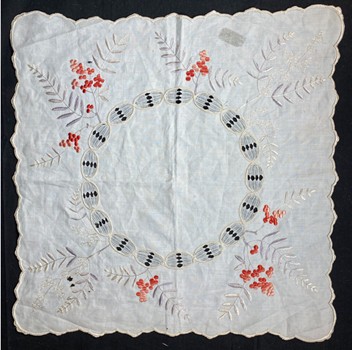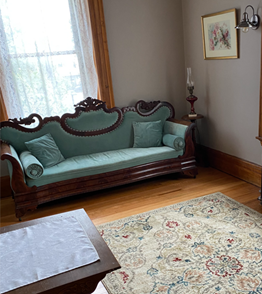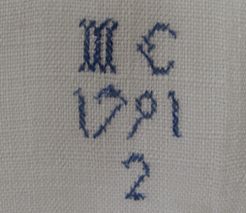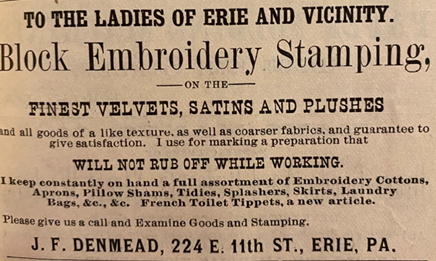Sometimes when we really take a close look at an object, just to be with it in the present without our minds wandering, we see things differently. I have had that very opportunity lately.

This 16-inch square piece of fabric has been hanging around my office for about a month now. It was intended to go in the Watson-Curtze’s bridal preparation room on the second floor. In case you hadn’t heard, we now have a room available for brides to get changed or relax in if they have rented out the mansion for their wedding or reception. The damage on the piece did not compel me to put in the room, but I liked it. Unfortunately, if there was a catalog number on it (there is evidence of tape on the fabric, a practice that isn’t done anymore), it fell off long ago. Consequently, I have no idea about the donor or any specific information about the object. All I know for certain is that it is here, and it has damage.

So, I studied the piece; I really looked closely at it. It is made of fine linen with silk embroidery. Several kinds of stitches were used, satin stitch, padded satin stitch, buttonhole, stem stitch, straight stitch, pulled work and drawn work. Only one section was stitched by machine (the ovals with the four holes in them), the remainder was done by hand. The person who executed the piece was very skilled!
The art of embroidery began as early as 30,000 BC. It is defined as any decorative work done with a needle and thread or yarn. The word embroidery comes from the French word broderie which means “embellishment”. There are many techniques of embroidery with needlepoint, cross stitch and crewel being the most popular today. Historically, embroidery was produced for the Church and for royalty with the average person having little or none. The art takes time, and most people were just too busy trying to survive.
Eventually, the Industrial Revolution did allow for a rising middle class with some disposable income and leisure time. American girls and women were taught the art to show their “marriageability”. The practical skill of “marking” linens by embroidering a name or initials on sheets, pillowcases, etc., ensured that the pieces would return after being sent away for laundering.

Linens, like the piece hanging around my office were produced in the late 1800s and early 1900s. Today, antique shops usually have boxfuls of these pieces which women produced to decorate their homes and serve as tablecloths, dresser scarves, or other practical items.

Confession time - - - if you haven’t guessed, I embroider. I began as a young girl and I continue to stitch when time allows. Many years ago, one of grandmothers said to me “I can’t understand why you embroider. I had to as a girl and hated it and you don’t have to!”. Well, I loved it and I still do. A volunteer who works with me here at the Hagen History Center took up the hobby during the pandemic lockdown and showed me beautiful pictures of his work. I find the artform meditative and relaxing.
Getting back to our mystery piece of embroidery. I will never know who created the piece and exactly when, but it appears to be made anytime from the 1920s through 1940s. It took many hours to stitch by someone who knew what they were doing, and it is beautiful! Are those reasons to keep it in the collection? Maybe not, but it certainly has given me happiness by just taking a good, long look at it.
